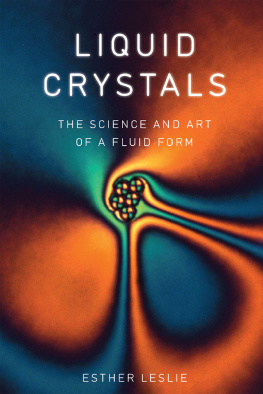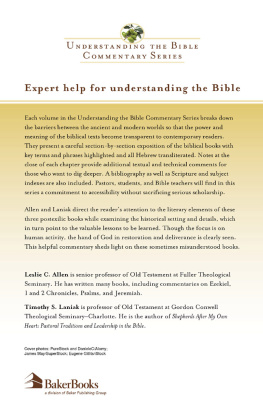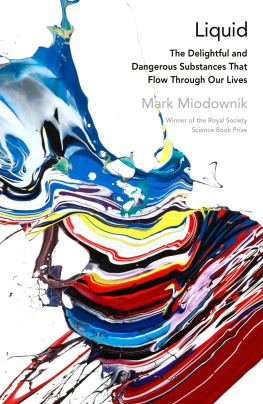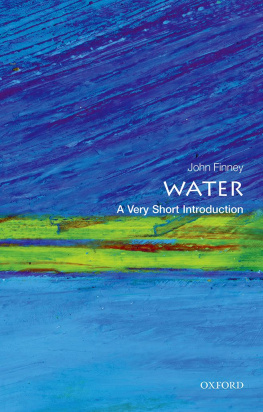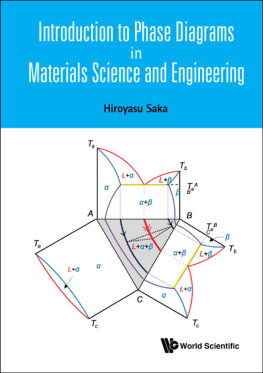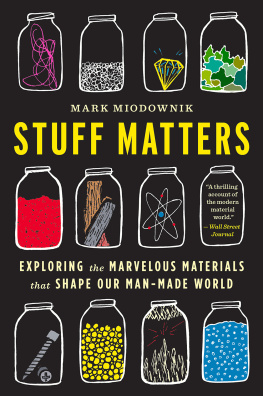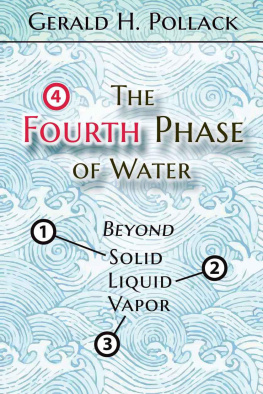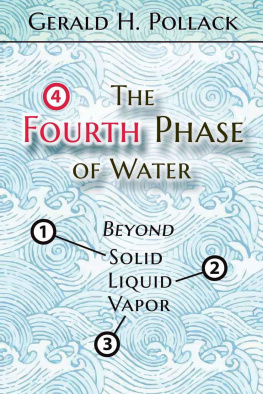LIQUID CRYSTALS

LIQUID
CRYSTALS
THE SCIENCE AND ART
OF A FLUID FORM
ESTHER LESLIE
REAKTION BOOKS
For Ben, Iris and Mordecai
Published by Reaktion Books Ltd
Unit 32, Waterside
4448 Wharf Road
London N1 7UX, UK
www.reaktionbooks.co.uk
First published 2016
Copyright Esther Leslie 2016
All rights reserved
No part of this publication may be reproduced, stored in a retrieval system, or transmitted, in any form or by any means, electronic, mechanical, photocopying, recording or otherwise, without the prior permission of the publishers
Page References in the Photo Acknowledgements and
Index Match the Printed Edition of this Book.
Printed and bound in Great Britain by TJ International, Padstow, Cornwall
A catalogue record for this book is available from the British Library
eISBN: 9781780236933
CONTENTS
INTRODUCTION: SLUSH
Caspar David Friedrichs Sea of Ice; the frosty sublime; imagined shipwrecks; Hamburg; the moon, the sea, the earth; Kant and the trade winds; diamonds; money, liquid and crystal; frozen wastes of abstraction; ice-up; money as a liquid crystal; as if; liquidation of the self; everything is water; society is no solid crystal; crystals in crystal; melting polar caps; black ice; Urforms and liquid crystal screens; states, phases and metaphors; stabil, labil; matter and thought; water; displays; clouds; liquid crystals
Eismeer
There is an old image of liquid crystal. It is an image of liquid turned crystal and crystal amid liquid. It is a painting known in German as Das Eismeer, which literally means the ice sea or the Sea of Ice, and refers to a polar sea, such as is found in the outermost North or most extreme South of the globe. The painting, from 18234, depicts what Caspar David Friedrich imagined to be the Arctic sea. The vision was a made-up one, for he had never seen that sea. He had never travelled to the northernmost North. The painting Das Eismeer has been displayed under various titles. In the year of its completion, it was shown in Prague as Ideal Scene of an Arctic Sea, a Shattered Ship under Piled-up Masses of Ice. That same year it was shown in Dresden as The Sea of Ice. At other times it was known as Ice Image: The Unsuccessful North Pole Expedition and as Winter Landscape with Large Ice Bergs or the Unsuccessful Hope in the Polar Sea after Parrys Journey.
The Sea of Ice depicts expanses of ice amid seawater under a frozen sky. Above the horizon there is only the tiniest hint of possible warmth, The image commissioned by the wealthy Leipzig patron was the partner of a counter-image by Johann Martin von Rohden illustrating the Arcadian South.
The Sea of Ice provides no dramatic vision of a boiling, raging sea, or lightning flashes, howling storms or sudden avalanches. There is no sonic and visual drama of dramatic forces at work. The image shows a scene that is frozen and still, an image of an afterwards, a drama completed. It appears This is sublimity beyond the sublime drama of nature. It is a peculiarly cold sublime, in which sublime experience is displaced. This is a scene depicting the after-effects of natures immense and indifferent powers. It pictures the afterwards of sublime tumult, when everything might continue as ongoing catastrophe, or when, possibly, there might be respite, a caesura.
What is terrible or sublime for Kant, in his Analytic of the Sublime of 1790, is formlessness.himself into conceptualization. This figure, a purely philosophical construct, yet embodied in an individual cogito, is, notes Kant, composed of a simple substance, numerically identical, non-empirical, devoid of all physiological determination or effect, all cultural and historical determination. The transcendental subject of sublime experience is placeless, without time. Times liquidity is stilled. Specific location is replaced by a crystallization of space and the self. There is sheer self, without motion or quality. This figure, like the stiff, anonymous figures whose backs are seen in other paintings by Friedrich, surveys and holds the scene without tumbling or screaming, unmoved.
But there may not be so successful an encapsulation of the vast Arctic and its killing power in Friedrichs image. The sea and the ice collide in Sea of Ice and find not even one mind to encompass them within the frame. There is only the spectator standing outside of the painting, a spectator who is uncertain as to his or her positioning in relation to the scene. Unlike other paintings by Friedrich, such as The Monk by the Sea (180810) or Wanderer above the Sea of Fog (1818), where the viewer may stand in alignment with the back of a spectator, in this one there is no place included for a spectator to repose and contemplate the vision. The viewer in the gallery is slightly elevated vis--vis the scene, but the ground on which he or she stands is not shown and is unable to be hypothesized. Is the viewer stranded on the ice, or on the edge of the land that donates the earthy colours in the icy blocks? If the viewer knew, it might be a hint that the monstrous events could be reintegrated into reason. As it is, something far more undecided is intimated. The putative ground of the viewer is in flux.
The painting does not conform to Friedrich Schillers three-stage conception of the sublime from 1793.Christian redemption, political movement or historical defrosting, and so hopeful. But perhaps not. What is doubted here may be the optimism of the Kantian and Schillerian sublime, even as it outlines terror. It is worse than we can imagine. Or, we can only imagine, but never master, this crisis.
But, in truth, the image is contained in our minds after all, for we do contemplate it and find a position in front of it and turn away when our looking is done. However, the painting confuses its viewers, for its scale is unspecific or may be grasped only bit by bit. If the sublime viewer is guaranteed a certain placelessness and removal from history, this painting provides a visual form, for it too evokes placelessness and timelessness. The painting was criticized by Carl Tpfer, in 1826, for appearing to show a toy boat smashed amid ice from the river Elbe. The geography of The Sea of Ice, its frigid environment, is a composite, a symbolic nowhere that might be anywhere or everywhere and which was already a popular topic for new forms of optical media.
Intentional or not, this vagueness of place suggests the horrid insight that at all times, and in all places, nature opposes and wrecks us. Therein perhaps lies the paintings particular chilling beauty and terror, rendered in hyperrealistic form. It drew imaginatively, it is said, not on a real event, but a feared event, articulated in William Parrys memoir on his search for the Northwest Passage in 1820 (translated into German in 1822). Parry described the terrible possibility of his ship being locked in by ice and the crews certain death should that occur. The temporality of the painting is not that of the latest news, but a sort of history, or a possible history that never indeed occurred. It falls into mythic time, nevertime or evertime. Geography is abstracted into spaces of lifelessness.
Perhaps the image represents, in oblique form, a sense of the earth as a place of interplay between the liquid and the crystalline, such as existed in the imagination of men of the painters day. In an aside to a lecture on the philosophy of nature from the 1830s, G.W.F. Hegel notes that the earth is not a heavenly body that is crystalline, such as the moon, which is a waterless crystal that is frozen and ashen and seeks to integrate itself with Here the liquid and the crystal, the sea and the ice, enact a drama between themselves the humans its victims or mere observers. In Friedrichs imagined moment of the sea of ice, however, the forces of freeze appear to be more powerful. Is the triumph of ice-up a temporary one? Will the waters come again, for that is natures cycle? Will the earth right itself and the dynamic play of forces, amid which we humans plot and pace intended and unintended paths, then continue?

